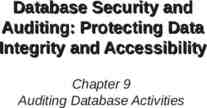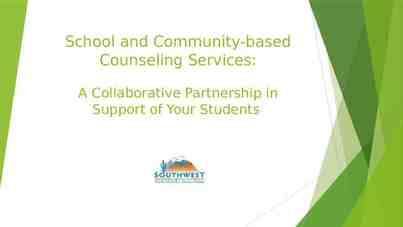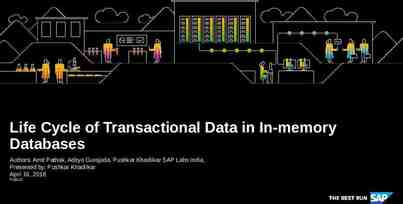MSG312 Microsoft Exchange Server 2007: Deployment and Migration
46 Slides2.54 MB
MSG312 Microsoft Exchange Server 2007: Deployment and Migration
Key Exchange Server 2007 Themes Improved Access to Inbox from various devices Separate functions and roles for easier deployment Enhance Management Capability (PowerShell) Significantly improved scalability Enhanced High Availability
Requirements
Hardware Requirements Production environment Intel Xeon Pentium 4 64-bit processor AMD Opteron 64-bit processor Minimum 512 MB of RAM Several GBs more likely 1 GB disk space on installation drive 200 MB on system drive
Server Requirements Microsoft Windows Server 2003 SP1 Microsoft Windows Server 2003 R2 supported Microsoft .NET Framework 2.0 MMC 3.0 Both above are auto-installed if not present NTFS File Systems throughout system, binaries, logs, databases, other Exchange Server 2007 files
Server Role Requirements Server Role Requirements Mailbox Network COM Access IIS WWW Service Client Access WWW Service Enable ASP .NET Unified Messaging Speechify Hub Transport IIS Edge Transport IIS
Client Requirements MAPI Access Preferably Outlook 2007, Outlook 2003, Outlook 2002 Outlook Web Access Basic Authentication, Forms-based Authentication Any browser Digest, Integrated Windows Generally Microsoft Internet Explorer 5 Mobile Access Windows Mobile 2003 and Windows Mobile 5 devices Push requires WM5 and MSFP Note NO OMA support POP3 and IMAP4 Also, note requirement for Loadsim Web Release 2.3
Deploying Exchange Server 2007
Installation Comprehensive Pre-installation checking Schema changes and domain prep Can be performed during installation Select roles to install
Installation Prerequisites Windows Server Active Directory Forest Schema Master DC must have Windows 2003 SP1 GC servers running Windows 2003 or higher AD Domain Functional Level Windows 2000 Server-native or higher in all domains A GC in the domain into which you are installing Forest Functional Level Windows Server 2003 No Exchange 5.5 servers in the organization (if migrating) Forest Preparation using SETUP/PrepareAD
Permissions Install using account that is member of: Local Administrator on the server AD Enterprise Administrator AD Domain Administrator Exchange Permissions Admin on Exchange Organization object
Role Selection Additional Role selection available through Add/Remove Programs
Installation Progress
Unattended Installation Setup.exe /console /roles: roles to install Bridgehead (BH, B); ClientAccess (CA, C); Gateway (GW, G); Mailbox (MB, M); UnifiedMessaging (UM, U) /mode: setup mode Install, Upgrade, Uninstall, RecoverServer /targetdir: folder /DomainController /prepareAD /prepareSchema
Validating Exchange Server 2007 Installation After installing Exchange Server 2007 Run get-ExchangeServer from PowerShell Displays all installed server roles Check Event Viewer for Events 1003 and 1004 in application log Run ExBPA Check Help Files for additional tasks
Deploy Supporting AD Infrastructure Upgrade/replace existing DCs and GCs where necessary Use 64-bit hardware (recommended) Orgs with more than 20,000 objects will benefit Also orgs with DIT 3 GB will benefit from increased address space (assuming sufficient physical memory) Consolidation hand-in-hand with 64-bit One 64-bit GC (dual CPU, 14 GB memory) can handle the workload of 11 32-bit GCs to support 20,000 Exchange Server mailboxes 11GB DIT: 350,000 objects Database caching occurs during normal e-mail activity – no prior loading
Roles and Topology
Exchange Server 2007 Server Roles Five Server Roles Mailbox Server Role Hub Transport Server Role Edge Transport Server Role Client Access Server Role Unified Messaging Server Role
Server Role Architecture Enterprise network Other SMTP Servers I N T E R N E T Edge Services Routin Routin g g Bridgehead Services Hygien Hygien Hygien ee e Routing OWA Protocols: Programmability: Web services, Web parts Client Access Services Policy Unified Messaging Services Applications: ActiveSync, POP, IMAP, RPC / HTTP PBX or VoIP Mailbox Services Mailbo x Public Folders Voice Messagin g Fax
Mailbox Server Role Traditional Role Hosts mailboxes and PFs (if present) Provides MAPI access to mailboxes Can communicate with multiple hubs But not in other sites, only in same site Supports cluster configuration No cluster support for other roles
Unified Messaging Server Role Messaging Services (Voice and fax) Outlook Voice Access E-mail, voice mail, calendar, contacts Call Answering Outlook Outlook Web Access Automated Attendant
Client Access Server Role Provides client access for Outlook Web Access, POP3, IMAP4, RPC/HTTP, ActiveSync Proxies or redirect connections to other Client Access servers Proxy to Mailbox co-located preferred to ‘random’ selection Provides Auto Connect functionality for Microsoft Office Outlook 2007 Provide OAB (if no PFs in use) Provide access to SharePoint sites and file for Microsoft Outlook Web Access (OWA) and Active Sync connections Performs re-direct and proxy functions to other Client Access Servers Locate at least one Client Access Server in each site that contains Mailbox Servers
Proxy vs. Redirect Proxy Client Access server uses MAPI to communicate with Mailbox server Proxy access implies HTTP use across network if initial Client Access server is remote from Mailbox server Redirect Preferred Client Access server for specific Mailbox server Useful when mailboxes have been moved and are remote from original Client Access server
Client Connectivity Architecture
AutoConnect Configure MAPI, OWA, ActiveSync, RPC/HTTP, IMAP4, or POP3 client with best Client Access Server Multi-step process: Client uses e-mail address to lookup AD and determine local Client Access server Contacts local Client Access server with an XML request Client Access server issues XML file with configuration details for the client Deals well with mailbox moves, etc.
Client Access and Mixed Exchange Client Access Server Maintains legacy access to Exchange 2000 Server and Exchange Server 2003 Back End servers Legacy OWA user experience maintained Exchange Server 2007 OWA experience Requires Exchange Server 2007 Client Access Server, AND Exchange Server 2007 Mailbox Server You cannot use an Exchange Server 2000 or Exchange Server 2003 Front End server to connect to an Exchange Server 2007 Mailbox Server
Hub Transport Role Processes message for delivery across the organization Routing predictability Application of policies Ensure Hub Transport Role in every site that has Mailbox Servers Even when two users on the same database exchange e-mail, Hub Server is engaged Connectivity to Exchange Server 2003 via Connectors
Hub Transport Routing
Edge Transport Role Edge Transport Role must be on dedicated server All other roles may be co-located May be co-located with ISA Server function Edge Transport (always connects to Hub) Use standalone server (can be on domain-joined server) Not generally connected to AD Forest Wizard config for Edge/Hub connection (EdgeSync) Requires AD Application Mode (ADAM) ADAM installed during Edge Server install Used for storage of recipient/configuration info Org data and ADAM data in synch via EdgeSync Hashed recipient lists, routing info
EdgeSync Synchronize recipient details from AD to Edge server Only between Edge server and Hub Server Install EdgeSync Management Tool on Hub Uses Wizard for configuration (XML file) EdgeSync.exe (sync scheduling mechanism?) Uses LDAP (special port:1389) Edge Services Routin g Hygien e Bridgehead Services Routing Policy
Edge Transport Functions Executes Message Hygiene Agents Address Rewrite agent (example below) Enable-TransportAgent -Identity "Address Rewriting Inbound agent" New-AddressRewriteEntry -Name "Swap" -InternalAddress "[email protected]" -ExternalAddress "[email protected]" Connection Filter agent Recipient Filter agent Sender Filter agent Sender ID agent Content Filter agent Protocol Analysis agent Note: Message Hygiene can also be deployed on Hub server Note also: Per-user SCLs and per-user Safe Senders
Topology Exchange Server 2007 topology is based on AD sites Many organizations can rely on default Especially if existing RG design based on AD sites May use AD Sites to regulate access to DCs/GCs Exchange routing table is subset of site topology Note that all mail routing is Direct Relay Direct Relay is Hub-to-Hub Inter-site relay uses SMTP Intra-site relay uses MAPI Therefore, every site with Mailbox servers Requires at least one Hub Server role Co-located Hub servers have higher precedence No i/b optimization of Hub selection (co-located scenario)
Coexistence and Migration
Coexistence with Exchange Server 5.5 No coexistence with Exchange Server 5.5 Complete upgrades to Exchange Server 2000 or Exchange Server 2003 (recommend latest SPs) All Exchange Server 5.5 servers must be decommissioned Exchange org must be in Native Mode Exchange Server 5.5 migrations only possible via Inter-Organizational migrations
Installing Exchange Server 2007 into Existing Organization Legacy organization auto detected during installation Little integration at the management level Exchange Server 2007 ESM v. Exchange Server 200[0 3] ESM E2007 servers visible in legacy ESM AG: Exchange Administrative Group random ID RG: Exchange Routing Group random ID Legacy mailboxes are displayed in Exchange Server 2007 ESM New objects created in Exchange Server 2007
Coexistence Example
Migrating Users Options Move Mailbox Wizard Move-Mailbox command Move-mailbox alias -TargetDatabase name Example Move-mailbox carrie -targetdatabase "Mailbox database" Restrictions Cannot use E200[0 3] MMW to move mailboxes from Exchange Server 2007 to Exchange Server 200[0 3] servers Cannot use Exchange Server 200[0 3] MMW to move mailboxes from Exchange Server 200[0 3] to
Move Mailbox
Move Mailbox
MSH Move Mailbox
PowerShell Move Mailbox
Legacy Restrictions
Summary Start planning for 64-bit Understanding New Role architecture is key to Deployment Many new requirements in terms of servers No coexistence with Exchange 5.5 No in-place upgrade capability with Exchange Server 2000 and Exchange Server 2003 Move mailbox-only supported approach Traditional Wizard-based approach
Resources Technical Chats and Webcasts http://www.microsoft.com/communities/chats/default.mspx http://www.microsoft.com/usa/webcasts/default.asp Microsoft Learning and Certification http://www.microsoft.com/learning/default.mspx MSDN & TechNet http://microsoft.com/msdn http://microsoft.com/technet Virtual Labs http://www.microsoft.com/technet/traincert/virtuallab/rms.mspx Newsgroups http://communities2.microsoft.com/ communities/newsgroups/en-us/default.aspx Technical Community Sites http://www.microsoft.com/communities/default.mspx User Groups http://www.microsoft.com/communities/usergroups/default.mspx
session evaluation







